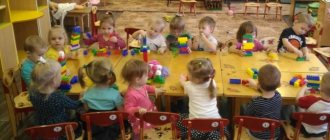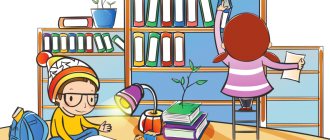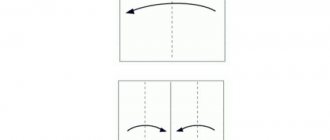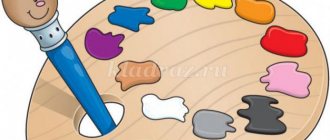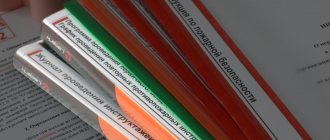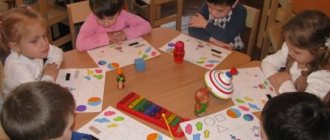Long-term planning for manual labor in the pre-school group
Valentina Kartavaya
Long-term planning for manual labor in the pre-school group
September
1. “Basket” (made of paper and cardboard)
Objectives: To strengthen children’s ability to work according to a pattern (make a square box). Develop the ability to carefully make cuts along the pattern and glue the sides. Foster independence and initiative. Develop a caring attitude towards your comrades.
2. Packaging design. "Groceries Box"
(paper, cardboard)
Objectives: To consolidate the ability to correctly fold a square sheet of paper into 16 small squares, to independently make a pattern for a cubic box.
Develop design abilities, creative thinking, enrich speech.
Foster activity.
October
1. "Mushroom"
Objectives: To increase children's interest in making crafts using the origami technique; Strengthen the ability to follow the teacher’s instructions; Develop fine motor skills of the hands; Cultivate neatness.
2. “Ladybug” (walnut shell)
Objectives: Teach children to make toys according to a model, use plasticine to connect parts of the toy. To form an interest in this type of work, to develop imagination. Follow the rules for working with plasticine and handle the natural material carefully.
November
1. "Swan"
Objectives: Continue to develop in children the desire to engage in manual labor and use skills in working with natural materials. Continue to teach children how to make crafts based on drawings, combine different materials in one craft, and fasten them together using sticks and plasticine. Develop creative imagination, fantasy, cultivate artistic taste, patience, attention, observation.
2. “Vegetables and fruits, healthy products”
(fabric applique)
Tasks: Teach children appliqué from fabric - select color, texture depending on the image being created, outline a stencil with chalk, carefully cut it out, assemble a picture from several parts.
Develop color perception and independence.
December
1. "Snowman"
Objectives: To increase children's interest in making crafts using the origami technique; Strengthen the ability to follow the teacher’s instructions; Develop fine motor skills of the hands; Cultivate neatness.
2. “Fairytale House”.
(made of paper and cardboard)
Objectives: Learn to make a new toy, conveying a fairy-tale image in it (a hut on chicken legs, etc.). Strengthen previously acquired skills in working with paper. Develop children's imagination and creative abilities. Develop the ability to maintain correct posture while working and take care of the health of others.
3. “Three-sided flashlight.”
(made of paper and cardboard)
Objectives: Learn to make a toy using the technique of gluing a pattern. Develop children's imagination. Strengthen the ability to fold paper in a certain sequence and carefully iron the fold lines, carefully cut out decorations for the product. Observe safety precautions when working with scissors.
January
1. "Toy store"
(made of paper and cardboard)
Objectives: Teach children to make toys from paper. Strengthen the ability to fold a rectangular sheet of paper in half, smooth out the fold lines, and cut the blank along the contour. Develop creativity when designing crafts. Follow the rules for working with scissors.
2. “Tablecloth - self-assembled” (weaving from paper)
Objectives: Improve the ability to create form as the basis for a future composition. Improve applique technique: cut with scissors in a straight line, not reaching the edge, intertwine paper strips. Develop dexterity.
Cultivate a love for your home, a desire to make it cozy and beautiful.
February
1. “Machine” (designed
made from matchboxes)
Objectives: To fix in the process of designing from waste material using the method of volumetric modeling the names of vehicles and their purpose; to educate children in safe behavior skills in various road situations and when riding a bicycle.
2. “Rocket” (airplane)
Objectives: To teach children to create an aircraft (spacecraft, using constructive and combined methods from waste material; to arouse interest in designing ships from paper; to form moral and patriotic feelings; to instill in children pride in their country and the achievements of scientists and astronauts; to develop fine motor skills.
March
1. “Beads made from pasta” (bracelet)
Objectives: Educational – to develop the ability to string small and large objects (pasta) onto a thread in alternation; arouse interest in creating a beautiful handmade decoration. Developmental – develop motor skills of the fingertips, a sense of rhythm; develop aesthetic perception.
Educational - to cultivate the desire to create for a loved one - mother, grandmother; cultivate interest in constructive activities.
2. "Tulips"
Objectives: To increase children's interest in making crafts using the origami technique; Strengthen the ability to follow the teacher’s instructions; Develop fine motor skills of the hands; Cultivate neatness.
April
1. “Sun” (from threads)
Objectives: To develop the artistic and aesthetic capabilities of children in creating compositions from woolen threads. Learn how to make a composition from woolen threads.
2. "Wagon"
(from materials used)
Objectives: Teach children to paste over finished boxes with colored paper, after making a pattern. Develop attentiveness, accuracy, and the ability to perform crafts in a certain sequence. Strengthen previously acquired skills in working with paper, careful handling of scissors.
3. “Bookmark”
Objectives: Teach children to make bookmarks for books with their own hands. Develop fine motor skills, eye, interest in your work, imagination, aesthetic taste. Improve your skills and abilities.
May
1. “Fantasies from an accordion”
Objectives: Expand the experience of artistic design of various products based on a generalized method of shaping (accordion)
Develop creative abilities.
Cultivate patience and accuracy.
2. “Frame for family photo”
Objectives: Introduce children to a new way to use cardboard, make a frame for a family photo.
Develop fine motor skills and creative imagination.
Foster love for family and hospitality.
3. "Check"
Objectives: To increase children's interest in making crafts using the origami technique; Strengthen the ability to follow the teacher’s instructions; Develop fine motor skills of the hands; Cultivate neatness.
